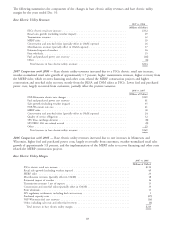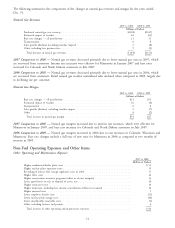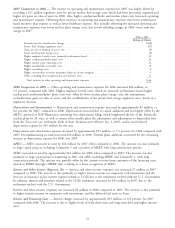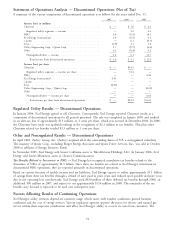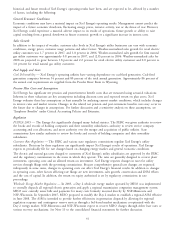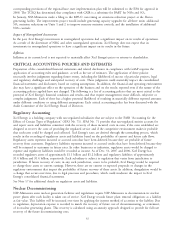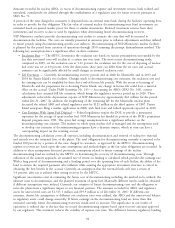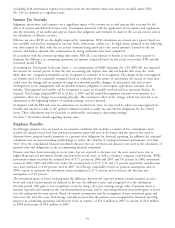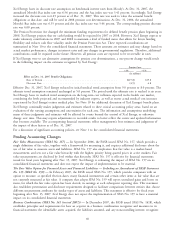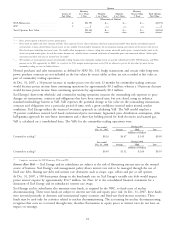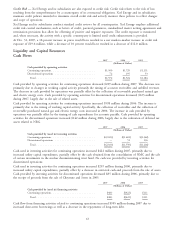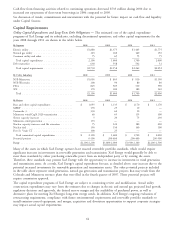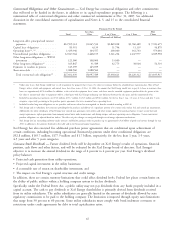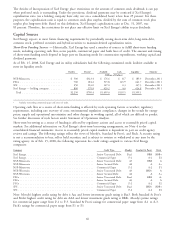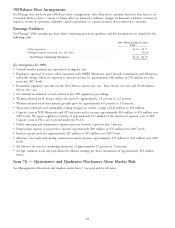Xcel Energy 2007 Annual Report Download - page 69
Download and view the complete annual report
Please find page 69 of the 2007 Xcel Energy annual report below. You can navigate through the pages in the report by either clicking on the pages listed below, or by using the keyword search tool below to find specific information within the annual report.(including both depreciation expense less returns from the investments fund) and amounts recorded under SFAS
No. 143 are deferred as a regulatory asset.
Income Tax Accruals
Judgment, uncertainty, and estimates are a significant aspect of the income tax accrual process that accounts for the
effects of current and deferred income taxes. Uncertainty associated with the application of tax statutes and regulations
and the outcomes of tax audits and appeals require that judgment and estimates be made in the accrual process and in
the calculation of effective tax rates.
Effective tax rates (ETR) are also highly impacted by assumptions. ETR calculations are revised every quarter based on
best available year-end tax assumptions (income levels, deductions, credits, etc.) by legal entity; adjusted in the following
year after returns are filed, with the tax accrual estimates being trued-up to the actual amounts claimed on the tax
returns; and further adjusted after examinations by taxing authorities have been completed.
In accordance with the interim reporting rules under APB 28, a tax expense or benefit is recorded every quarter to
eliminate the difference in continuing operations tax expense computed based on the actual year-to-date ETR and the
forecasted annual ETR.
Accounting for Uncertainty in Income Taxes — an interpretation of FASB Statement No. 109 (FIN 48), has impacted
the income tax accrual process in that the new accounting rule requires that only tax benefits that meet the ‘‘more
likely than not’’ recognition threshold can be recognized or continue to be recognized. The change in the unrecognized
tax benefits need to be reasonably estimated based on evaluation of the nature of uncertainty, the nature of event that
could cause the change and an estimate of range of reasonably possible changes. At any period end, and as new
developments occur, management will use prudent business judgment to unrecognize appropriate amounts of tax
benefits. Unrecognized tax benefits can be recognized as issues are favorably resolved and loss exposures decline. As
required, Xcel Energy adopted FIN 48 as of Jan. 1, 2007 and the initial derecognition amounts were reported as a
cumulative effect of a change in accounting principle. The cumulative effect of the change, which was reported as an
adjustment to the beginning balance of retained earnings, was not material.
As disputes with the IRS and state tax authorities are resolved over time, we may need to adjust our unrecognized tax
benefits and interest accruals to the updated estimates needed to satisfy tax and interest obligations for the related
issues. These adjustments may be favorable or unfavorable, increasing or decreasing earnings.
See Note 7 for further details regarding income taxes.
Employee Benefits
Xcel Energy’s pension costs are based on an actuarial calculation that includes a number of key assumptions, most
notably the annual return level that pension investment assets will earn in the future and the interest rate used to
discount future pension benefit payments to a present value obligation for financial reporting. In addition, the actuarial
calculation uses an asset-smoothing methodology to reduce the volatility of varying investment performance over time.
Note 10 to the consolidated financial statements discusses the rate of return and discount rate used in the calculation of
pension costs and obligations in the accompanying financial statements.
Pension costs have been increasing in recent years, but are expected to decrease over the next several years, due to
higher-than-expected investment returns experienced in recent years, as well as voluntary company contributions. While
investment returns exceeded the assumed level of 8.75 percent in 2006 and 2005 and 9.0 percent in 2004, investment
returns in 2007, 2003 and 2002 were below the assumed level of 8.75, 9.25 and 9.5 percent respectively, and discount
rates have increased to 6.00 percent used in 2007. Xcel Energy continually reviews its pension assumptions and, in
2008, expects to maintain the investment return assumption at 8.75 percent and to increase the discount rate
assumption to 6.25 percent.
The investment gains or losses resulting from the difference between the expected pension returns assumed on asset
levels and actual returns earned are deferred in the year the difference arises and recognized over the subsequent
five-year period. This gain or loss recognition occurs by using a five-year, moving-average value of pension assets to
measure expected asset returns in the cost-determination process, and by amortizing deferred investment gains or losses
over the subsequent five-year period. Based on current assumptions and the recognition of past investment gains and
losses over the next five years, Xcel Energy currently projects that the pension costs recognized for financial reporting
purposes in continuing operations will decrease from an expense, of $11.4 million in 2007 to income of $6.0 million
in 2008 and income of $8.4 million in 2009.
59


